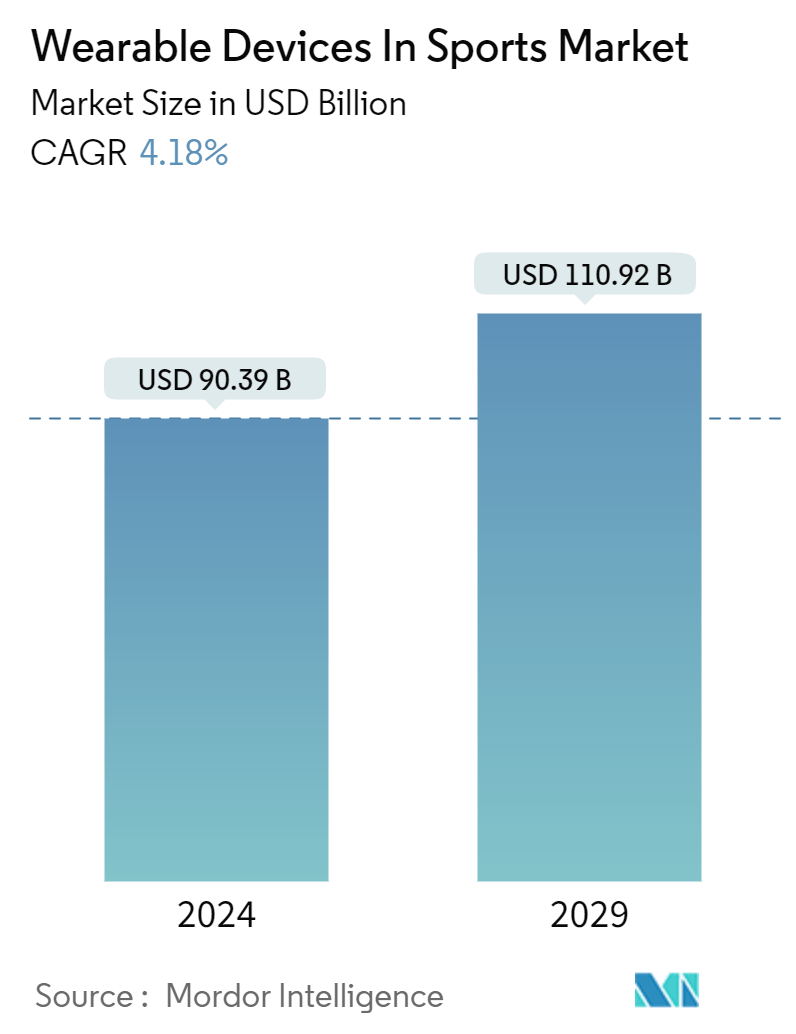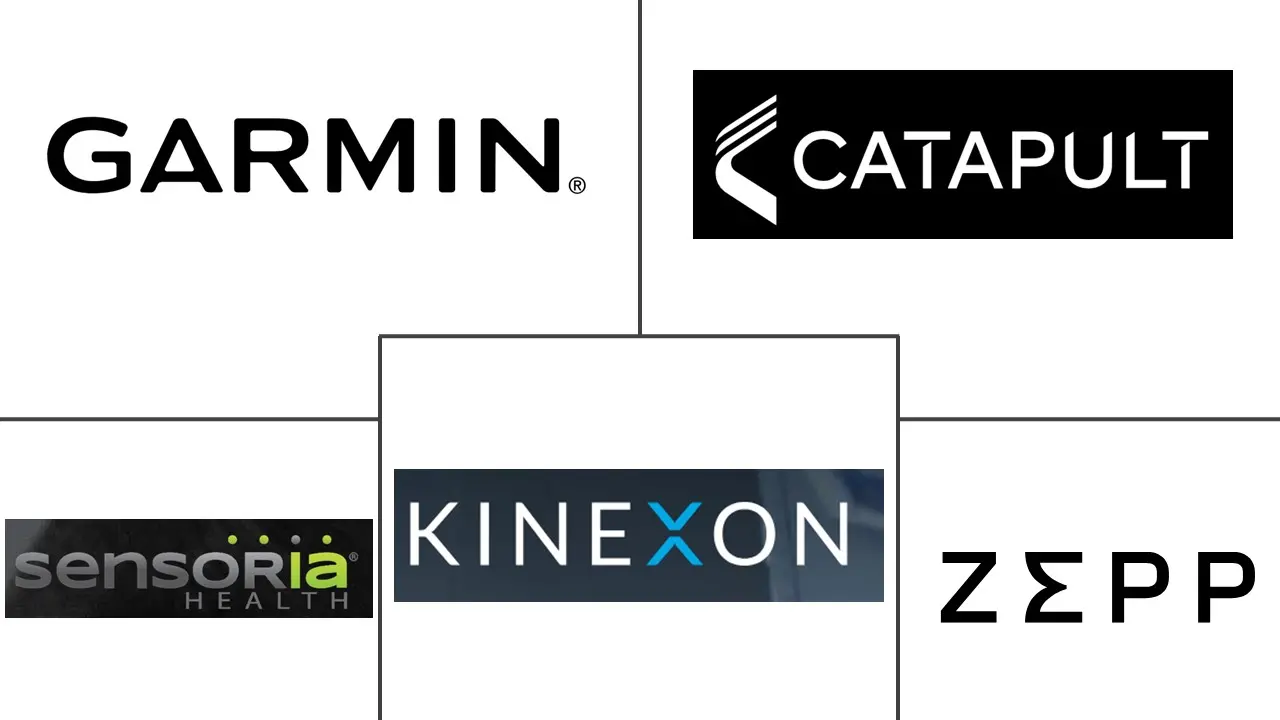Market Size of Wearable Devices In Sports Industry

| Study Period | 2019 - 2029 |
| Market Size (2024) | USD 90.39 Billion |
| Market Size (2029) | USD 110.92 Billion |
| CAGR (2024 - 2029) | 4.18 % |
| Fastest Growing Market | Asia Pacific |
| Largest Market | North America |
Major Players
*Disclaimer: Major Players sorted in no particular order |
Sports Wearable Devices Market Analysis
The Wearable Devices In Sports Market size is estimated at USD 90.39 billion in 2024, and is expected to reach USD 110.92 billion by 2029, growing at a CAGR of 4.18% during the forecast period (2024-2029).
The wearable technology and devices market is unfolding at a rapid pace. With the industry going towards a focal point, businesses are prioritizing service enhancement, apart from adding additional new features to the device itself.
- Wearable devices have remained a significant part of the sports industry, supporting the athlete to stick to daily routines and giving important information on various parameters it is programmed to control. Integration of analytics tools for better evaluating and analyzing this data to improve the performance or handling of overall personal fitness has sustained the need for wearable devices in the sports industry.
- The growth in the wearables market can be attributed to increasing demand coupled with the propagation and suitability of improved communications protocol and miniaturization of sensor technology. Sensors and wearable devices can be combined into multiple accessories such as wristwear, garments, shoes, and eyeglasses because of their compressed or compact size and superior integration technologies.
- The factors influencing wearable devices in the sports market include the entry of big players, portable and comfortable usage, elevated healthcare awareness, the soaring cost of manufacturing, and technological progressions. These essential factors have encouraged the adoption of wearable devices. Wearable devices such as activity trackers, smartwatches, and smart clothing are preferred among customers owing to their numerous advantages, including portable usage and the most modern and advanced technological advancements.
- The increasing number of sports events, both online and offline, has indeed been a significant driver for the wearable devices market in sports. The rise in sports events, including professional competitions, amateur tournaments, and community-driven activities, has created a demand for wearable devices to enhance the sports experience, provide real-time data, and track performance metrics.
- Wearable electronic devices find various applications in fitness and sports for controlling and monitoring parameters such as heart rate, calorie consumption, sleep, and blood pressure. Wearable devices permit a user to check health-related information on their smart wearables.
- One of the main obstacles anticipated to restrain the market's expansion during the forecast period is the high cost of innovative wearable technology. Most firms in this sector are releasing their products under the category of premium products, which are not affordable for many users and restrict the products from reaching economies of scale.
Sports Wearable Devices Industry Segmentation
Wearable technology (also called wearable gadgets) that athletes and sports teams use is considered in the market scope. Wearables used for sports, like consumer wearables, often incorporate tracking information associated with health and fitness. Sports wearables work with other analytical applications that provide actionable insights to increase productivity and future planning. These wearable devices have minute motion sensors to capture data and synchronize with mobile devices.
The wearable devices in sports market are segmented by device type (fitness & heart rate monitors, smart clothing, GPS trackers, and other device types) and geography (North America, Europe, Asia Pacific, Latin America, and Middle East and Africa).
The market sizes and forecasts are provided in terms of value in USD for all the above segments.
| By Device Type | |
| Fitness & Heart Rate Monitors | |
| Smart Clothing | |
| GPS Trackers | |
| Other Devices (Cameras, etc) |
| By Geography*** | |
| North America | |
| Europe | |
| Asia | |
| Australia and New Zealand | |
| Latin America |
Wearable Devices In Sports Market Size Summary
The wearable devices technology in the sports market is experiencing significant growth, driven by the increasing integration of advanced analytics and sensor technologies into sports and fitness activities. These devices, which include activity trackers, smartwatches, and smart clothing, are becoming essential tools for athletes and fitness enthusiasts, providing real-time data and insights to enhance performance and monitor health metrics. The market is characterized by rapid technological advancements, with companies focusing on enhancing user experience through improved communication protocols and miniaturization of sensors. The proliferation of sports events, both online and offline, has further fueled the demand for wearable devices, as they offer valuable data to improve athletic performance and engagement.
In North America, the wearable devices market in sports is particularly robust, with significant contributions from US-based companies and innovations in smart clothing and fitness-tracking technologies. The region's market growth is supported by a strong focus on health and fitness, leading to increased adoption of wearable devices. Major players in the market, such as Garmin Ltd., Zepp US Inc., and Catapult Sports Pty Ltd., are actively pursuing strategies like partnerships and product innovations to maintain a competitive edge. Despite the high cost of advanced wearable technology posing a challenge, the market continues to expand, with smart fabrics and IoT-based garments gaining traction for their potential applications in various sectors, including military and healthcare.
Wearable Devices In Sports Market Size - Table of Contents
-
1. MARKET DYNAMICS
-
1.1 Market Overview
-
1.2 Industry Attractiveness - Porter's Five Forces Analysis
-
1.2.1 Threat of New Entrants
-
1.2.2 Bargaining Power of Buyers/Consumers
-
1.2.3 Bargaining Power of Suppliers
-
1.2.4 Threat of Substitute Products
-
1.2.5 Intensity of Competitive Rivalry
-
-
1.3 Impact of COVID-19 on the Market
-
-
2. MARKET SEGMENTATION
-
2.1 By Device Type
-
2.1.1 Fitness & Heart Rate Monitors
-
2.1.2 Smart Clothing
-
2.1.3 GPS Trackers
-
2.1.4 Other Devices (Cameras, etc)
-
-
2.2 By Geography***
-
2.2.1 North America
-
2.2.2 Europe
-
2.2.3 Asia
-
2.2.4 Australia and New Zealand
-
2.2.5 Latin America
-
-
Wearable Devices In Sports Market Size FAQs
How big is the Wearable Devices in Sports Market?
The Wearable Devices in Sports Market size is expected to reach USD 90.39 billion in 2024 and grow at a CAGR of 4.18% to reach USD 110.92 billion by 2029.
What is the current Wearable Devices in Sports Market size?
In 2024, the Wearable Devices in Sports Market size is expected to reach USD 90.39 billion.

